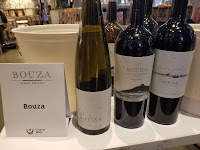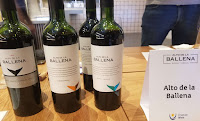
Last week the
Uruguay Wine Fall Tour landed in Washington DC where 16 producers poured several wines each at
La Cosecha (voted one of America's Top 50 Best Wine Retailers in 2021). The tour was sponsored by
Uruguay Wine, the brand used by
INAVI - Instituto Nacional de Vitivinicultura to promote Uruguayan wine around the world. During a previous tasting almost a decade ago, the emphasis was strictly on
Tannat -- introduced into Uruguay in 1870 by Basque immigrants and at the time had represented one-third of all wine produced in that country. And yes, there were several single-varietal Tannat wines and Tannat-based blends poured at this event. However, I was more impressed by the emergence of other grape varietals and stylistic changes.

Uruguay resides in the same parallels as its neighbors Argentina & Chile, but also South Africa, Australia, and New Zealand. The soils are mostly clay, there's plenty of sunshine, and the vineyards are primarily situated near the Rios de la Plata (across from Buenos Aires) or near the Atlantic Ocean. Think cool coastal breezes and balanced and structured wines. There's a relatively long wine-making tradition in the county as immigrants from Spain, Italy, and Germany brought their wine-making traditions and wine grapes with them.

The first new trend I noticed was the expansion of Albariño. The grape was introduced into Uruguay by the
Bouza Winery incorporating the family's Spanish roots from Galicia. They also farm several other winegrapes in five vineyards from the metropolitan areas of Montevideo and Canelones to the oceanic-influenced Maldonado region. These are Pinot Noir, Chardonnay, Riesling, Merlot, Tempranillo, and Tannat. The last three comprise their
Mount Vide Eu - a full-bodied and structured wine providing a robust mouthfeel. Yet, it was their tropical fruit and saline-driven
Albariño 2022 that piqued my interest in discovering who else was producing wines from this grape variety.
Bodega Garzon was the next station I visited and they poured a coastal and racy
Albariño Reserve 2022 that featured grapefruit and refreshing acids and minerality. In addition, their P
inot Noir Rosé 2022 was very provencal - elegant with layers of strawberries.
Another excellent example was provided by Familia Deicas and their Atlantico Sur Albariño. As the name suggests, the grapes are grown no further than 30 kilometers from the coast where the cooler temperatures allow for slow ripening and fresh wine. This version has similar acidity and saline as the Bouza but shows more floral and citrus notes. Familia Deicas has been very innovative throughout the years by producing the first Sauternes-style noble rot wine in Uruguay, the first ISO 9001 Quality Certification in South America, the first Tannat Liqueur in Uruguay, the first Tannat produced according to the Bordeaux Cru Garage techniques in Uruguay, and many others.
Winemaker Santiago Deicas has continued this innovation through his
Bizarra Extravaganza brand. This project began in 2014 when he started making craft beer and inspiration from the purity of that beverage triggered the concept of producing natural wines. Two of these wines were presented at the tasting: the
Vino Natural Amphora and
Vino Natural Orange. The former is made from 100% Tannat and aged two months in Amphora and 10 months in concrete tanks. The latter is composed of Gros Manseng and Petit Manseng and is aged nine months in used French oak and concrete tanks. Both are truly unique with the Amphora showing fruit-forward Tannat.
Another fruit-forward innovative wine was the
Pizzorno Maceracion Carbonica Tannat 2022. The wine was fermented using carbonic maceration in concrete tanks where, in a carbon dioxide-rich environment, most of the juice is fermented while still inside the grape. The resulting wine is low in tannins and showcases the grape's fruit - in this case, rich raspberries and cherries. The 4th generation at
Pizzorno Family Estates also poured a very elegant
Pinot Noir Reserve 2020 and a sturdy
Tannat Reserve 2020 with the grapes from all of these wines grown in the country's largest wine region: Canelones.
Another new perspective occurred while visiting the table for
Bodega Cerro Chapeu. This 10th-generation family started producing wine in Catalonia in 1792 and in Uruguay in 1930. They are located in the Cerro Chapeu of the Rivera wine region which is located in northern Uruguay - very close to the Brazilian border. This continental region is "characterized by its vineyards on the sides of hills and slopes, around 220 meters high, and its deep red sand soils with very good drainage and the seasons are drier with longer sun hours. Ideal for late-maturing varieties like Trebbiano and Malvasia. These are the grapes that form the
Castel Pujol Folklore Pet Nat. The grapes are fermented separately and right before complete fermentation, they are blended and bottled. I was not expecting a fun wine like this. They also poured a delicious still version of the Pet Nat, the
Castel Pujol Folklore Blanco, with plenty of fruitiness and surprisingly body. Finally, they continued to stretch traditional winemaking with the
Castel Pujol Folklore Tinto -- 80% Tannat co-pigmentation with 20% Petit Manseng first press skins. What a mouthfeel.

A similar co-fermentation occurred with
Alto de la Ballena and their
2018 Tannat - Viognier Reserve. This is an 85% - 15% co-fermented blend aged for nine months in American oak barrels. The Viognier softens the Tannat and provides a pleasant floral aroma. This 20-year-old winery is located in the southeast and seaside region of Maldonado and also produces a luscious
Cabernet Franc Reserve - silky and juicy in nature

Perhaps the most delicious Cabernet Franc was provided by
Bracco Basca and their
2021 Cabernet Franc. Layers of dark cherries, structured, and a long satisfying tail. The winery was founded in 2005 by Darwin Bracco and Mirtha Bosca "but its vineyards have been in the family for 5 generations. Originally from Piedmont, Italy, the family moved to Uruguay and established in Atlántida region to continue the wine tradition". This winery is also releasing several innovative products such as the first dry
Muscatel in Uruguay as well as a
Merlot - Ugni Blanc Claret. Fun, fantastic wines.
Looking forward to visiting all these wineries in person one day. Cheers.
 The Chrysalis Vineyards 2019 Buttorfleoge ($28) is a rarity. This is a Norton Pét-Nat, a new use for Virginia's native grape. In 2023 there were 130 acres of Norton planted in Virginia (10th most abundant in the Commonwealth(1)). The grape is usually seen as a rich and juicy dry wine that needs a few years in the bottle to tame its astringent nature. Yet, its versatility can be seen in the other styles such as a port-styled wine, a semi-dry lighter offering, and in various blends. But this is the first sparkling I've experienced via Pétillant Naturel using 100% whole-clustered pressed Norton wine. Expect the traditional dark purple color of the Norton but there is an unexpected strong floral note followed by blackberry bubbles.
The Chrysalis Vineyards 2019 Buttorfleoge ($28) is a rarity. This is a Norton Pét-Nat, a new use for Virginia's native grape. In 2023 there were 130 acres of Norton planted in Virginia (10th most abundant in the Commonwealth(1)). The grape is usually seen as a rich and juicy dry wine that needs a few years in the bottle to tame its astringent nature. Yet, its versatility can be seen in the other styles such as a port-styled wine, a semi-dry lighter offering, and in various blends. But this is the first sparkling I've experienced via Pétillant Naturel using 100% whole-clustered pressed Norton wine. Expect the traditional dark purple color of the Norton but there is an unexpected strong floral note followed by blackberry bubbles.






















































